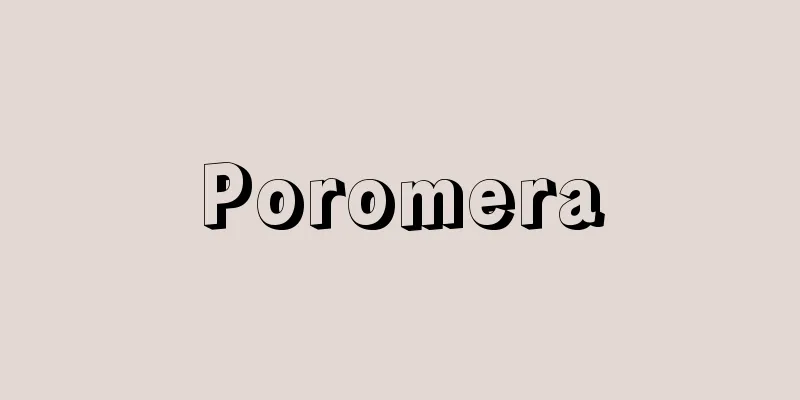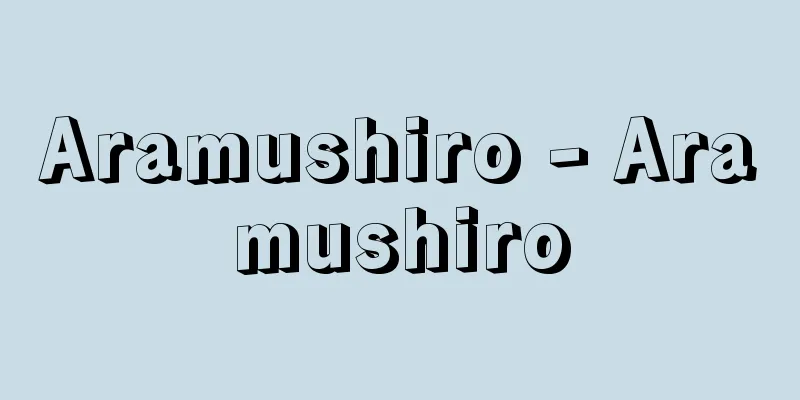Testicles

|
The central part of the male reproductive system, the organ that produces sperm. In human anatomy, it is called the testis. It is also commonly called kintama (golden testicles), which is said to be an abbreviated form of iki (vitamin) ('Daigenkai'). The Latin scientific name Testis means witness, and was used to refer to the testicles as evidence of maleness. For information on the testicles of mammals, please refer to the 'testicles' entry. The human testicles are a pair of organs, one on each side, located in the scrotum, which hangs down below the pubic symphysis, and are surrounded by two or three layers of membrane. They are slightly flattened, oval-shaped, with a long axis of 5 cm, a thickness of 2 cm, and a width of 3 cm, and weigh about 8 to 8.5 grams. Normally, the left testicle hangs lower than the right. The testicles are generally of a somewhat elastic hardness, but the substance of the testicles is covered by a thick connective tissue membrane called the tunica albuginea. This tunica albuginea thickens at the posterior edge of the testicle, protruding into the substance of the testicle as a hemispherical mass of tissue, forming the testicular mediastinum (testicular mediastinum). From the mediastinum of the testis, there are thin plates that radiate into the testicular substance, forming septa that divide the testicular substance into about 200 to 300 small compartments (testicular lobules, or testicular lobules). These lobules are filled with tiny curved seminiferous tubules that are in a roundabout manner, and sperm are produced in these tubes. There are about 1 to 4 curved seminiferous tubules in a testicular lobule, and they are long and roundabout. Each curved seminiferous tubule is about 30 to 80 centimeters long and 0.15 to 0.25 millimeters thick. The curved seminiferous tubules in each testicular lobule become a single short straight tubule as they approach the mediastinum of the testis, and these straight tubules form a net-like rete testis (rete testis) in the mediastinum. About 15 to 20 efferent ducts (ductus efferente testis) emerge from this rete testis and enter the epididymis (epididymis). The efferent ducts in the epididymis merge in a circuitous manner to form a single testicular duct (epididymal duct) that runs for about 5 to 6 centimeters before becoming the vas deferens. The curved seminiferous tubules, which produce spermatozoa, have a thin basal lamina on the outside, and the luminal wall of the tubule is made up of several layers of cells. Division and proliferation take place within these several layers of cell lineages, and ultimately spermatozoa are formed in this region. In other words, spermatogonia, which are male primitive germ cells, are arranged in contact with the basal lamina, and grow sequentially toward the center of the tubule into primary spermatocytes, secondary spermatocytes (sperm daughter cells), early spermatids, and late spermatids, and finally transform into spermatozoa. Sertoli cells are present between these growing cell groups, and are involved in protecting and supporting the developing spermatozoa, as well as in providing them with nutrients. Sertoli cells also perform phagocytic functions, such as engulfing degenerated cells in the curved seminiferous tubules, and secrete androgen-binding proteins. In the connective tissue that fills the outside of the seminiferous tubules, there are cells called Leydig cells (interstitial cells, interstitial cells), which secrete testosterone, which leads to the development of secondary male sexual characteristics. The testes develop as primordial germ cells in the posterior wall of the abdominal cavity around the fifth week of gestation. At about the seventh week, they become testes, although undifferentiated. Between the third month of gestation and birth, the testicular tissue migrates from its original position in the lumbar region to the scrotum, where it is suspended. The scrotum keeps the testes at a lower temperature than the abdominal cavity, helping sperm development. The testicular arteries that distribute to the testes arise directly from the abdominal aorta at the level of the second lumbar vertebra, which corresponds to the height at which the testicular primordia develop. The testicular artery extends as the testes descend, passing through the inguinal canal to reach the scrotum, and enters from the posterior edge of the testes, becoming a long, thin artery that runs along the posterior abdominal wall. Insufficient descent of the testes, where the testes do not descend, is said to occur in 14% of newborns. There are also cases where the descent is delayed and occurs during childhood. When a testicle remains somewhere along its descent path, it is called an undescended or cryptorchidism (cryptorchidism). It can remain in the abdominal cavity or in the groin area, which can lead to various sexual dysfunctions and complications. A part of the abdominal muscle continues to the scrotum and is called the cremaster muscle. When the inside of the upper thigh is rubbed, the cremaster muscle reflexively contracts and pulls up the testicle, and because this reflex center is located in the lumbar spinal cord, this test is used to diagnose disorders of the spinal reflex. [Kazuyo Shimai] [References] | | | | |The left side of the figure is a side view, the right is a front view ©Shogakukan "> Male Genitalia Structure The figure shows a side view of the spermatic system . ©Shogakukan Names of parts of the testicles Source: Shogakukan Encyclopedia Nipponica About Encyclopedia Nipponica Information | Legend |
|
男性の生殖器官の中心となる部分で、精子を産生する器官。人体解剖学名では精巣とよぶ。俗称できんたま(金玉)ともよぶが、これは生(いき)の玉(たま)の上略音便であるという(『大言海』)。また、ラテン語学名のTestisは証人、目撃者の意で、男性であることの証拠ということから睾丸に用いられたという。なお、哺乳(ほにゅう)類の睾丸については、「精巣」の項を参照されたい。 ヒトの睾丸は、恥骨結合の下で下垂する陰嚢(いんのう)の中にあり、2~3層の被膜に包まれた左右1対の器官である。形はやや圧平された上下に長い楕円(だえん)体状で、長軸5センチメートル、厚さ2センチメートル、横幅3センチメートルほどの大きさで、重さは約8~8.5グラムである。普通には、左側睾丸が右側より低く下垂している場合が多い。全体としてやや弾力性のある硬さであるが、睾丸の実質は白膜(はくまく)とよばれる結合組織性の厚い被膜で覆われる。この白膜は睾丸の後縁で肥厚して半球状の組織塊として睾丸実質内に突出しており、睾丸縦隔(精巣縦隔)という部分を形成している。睾丸縦隔からは睾丸実質内に放射状に出る薄板があり、これが中隔となって睾丸実質内を200~300個ほどの小区画(睾丸小葉、あるいは精巣小葉)をつくっている。この小葉内に微細な曲精細管(精細管)が迂曲(うきょく)充満しており、この管内で精子が産生されている。睾丸小葉内の曲精細管は1~4本ほどで、長く迂曲して存在している。1本の曲精細管の長さは約30~80センチメートル、太さ0.15~0.25ミリメートルほどある。各睾丸小葉内の曲精細管は睾丸縦隔に近づくと1本の短い直精細管となり、これらの直精細管は縦隔内で網状の睾丸網(精巣網)を形成する。この睾丸網からは15~20本ほどの輸出管(精巣輸出管)が出て副睾丸(精巣上体)に入る。副睾丸内の各輸出管は迂曲しながら合流して前後に1本の睾丸体管(精巣上体管)となり、5~6センチメートルほど走ると精管に移行する。 精子を産生している曲精細管は外周に薄い基底板があり、管内腔(ないくう)壁は数層の細胞群が配列している。この数層の細胞系列のなかで分裂増殖が行われ、最終的には精子となるが、その連続的な分化過程の各段階がこの部分においてみられる。つまり、基底板に接して男性原始生殖細胞である精祖細胞が配列し、順次、管中心部に向かって一次精母細胞、二次精母細胞(精娘(せいじょう)細胞)、早期の精子細胞、後期精子細胞と成長し、最後に精子へと変換するわけである。これらの成長過程の細胞群の間にはセルトリ細胞が存在し、発育する精子の保護、支持のほか、栄養供給などに関与する。また、セルトリ細胞は曲精管内の変性細胞の貪食(どんしょく)などの食作用の働きや、アンドロゲン結合タンパクの分泌を行っている。精細管外を埋める結合組織内にはライディッヒ細胞(間細胞、間質細胞)とよぶ細胞があり、男性の第二次性徴の発達をもたらすテストステロンを分泌している。 睾丸の発生は原始生殖細胞として胎生5週目ころに腹腔の後壁に生じる。7週目くらいで未分化ながら精巣となり、胎生3か月から出生までの間に睾丸組織は最初の腰部の位置から陰嚢に移動し、つり下げられる。陰嚢は、睾丸を腹腔内よりも低温に保ち、精子発育を助ける働きをしている。睾丸に分布する睾丸動脈は、第2腰椎(ようつい)の高さで腹大動脈から直接おこるが、これは睾丸原基の発生時の高さにあたる。睾丸動脈は睾丸の下降とともに伸び、鼠径(そけい)管を通って陰嚢内に達し、睾丸の後縁から入るので、後腹壁を長く細く走る動脈となっている。睾丸が下降しない下降不全は新生児の14%にみられるといわれる。また下降が遅れて幼年期に下降する場合もある。下降経路の途中で、とどまるのを停留または潜在睾丸(精巣停留症)という。停留する部位は腹腔内とか鼠径部まであり、さまざまな性的機能障害や合併症が出ることもある。腹筋の一部は陰嚢まで続き挙睾筋(精巣挙筋)という。大腿(だいたい)上部の内側をこすると、挙睾筋が反射的に収縮し、睾丸を引き上げるが、この反射中枢が腰髄(ようずい)にあるため、この検査は脊髄(せきずい)反射の障害の診断法となる。 [嶋井和世] [参照項目] | | | | |図の左が側面図、右が正面図©Shogakukan"> 男性性器の構造 図は精管系を示す側面図©Shogakukan"> 精巣の各部名称 出典 小学館 日本大百科全書(ニッポニカ)日本大百科全書(ニッポニカ)について 情報 | 凡例 |
Recommend
Middle dance - Middle dance
A type of dance in Noh. It is moderate in nature a...
scavenger
...The second method involves selecting the right...
Kip, PJ - Ticket
...Kipp's gas generator is also called Kipp&#...
Flourens - Marie Jean Pierre Flourens
French physiologist. Born in Maureillan. Elected ...
Lysias (English spelling) Lȳsiās
[Born] Around 459 BC. Athens [Died] c. 380 BC Anci...
tommy shops (English) tommyshops
…Also called the truck system, this system was wi...
Kinenhama Beach
...Shochu, made from brown sugar, is a local spec...
Indanthrene dyes
A general term for high-grade vat dyes, including...
Kiyosumigiboshi - Kiyosumigiboshi
... H . sieboldiana (Lodd.) Engl. (illustration) ...
Onchugen - Ochugen
...It is said that this name comes from the fact ...
The Kioizaka Incident
In 1878 (Meiji 11), Councillor and Minister of Ho...
Westferish - Westferish
…The relatively easy integration of the region in...
Amuck (English spelling)
Aggressive attacks of mental confusion seen among ...
Onarihajime - Onarihajime
The arrival and departure of the imperial family, ...
Threshing - Dakkoku
The process of removing grains from stalks, branc...









